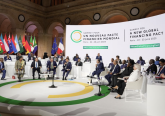Actors around the world have taken up increasingly ambitious strategies to tackle plastic pollution: public-private partnerships like the Circulate Capital Ocean Fund; European Union strategies like banning commonly used- single-use products; and large international conferences like Our Oceans. Still, plastic waste remains a tangible and prominent environmental issue. Policymakers are wondering if the current spate of solutions will be enough to bring us to mitigate plastic waste effectively. In this article, I will examine how much and what kind of effort would be needed to significantly reduce plastic pollution emissions. I leveraged research from The Plastic Pollution Emissions Working Group (PPEG). The PPEG—a team of scientists, policy wonks, and practitioners working together under a grant from the National Socio-Environmental Synthesis Centre—has attempted to quantify the flow of plastic into rivers, lakes and oceans.
How did we do this? We first started by investigating how much plastic pollution was leaking into aquatic environments like rivers, lakes, and oceans. We found this to be 24-35 million metric tonnes (Mt), more than three times the number of what is flowing into just oceans, which is what has been used to inform and guide policy responses to date. Understanding the enormity and diversity of the problem allowed us to then investigate the efficacy of policy responses to stemming the tide on plastic.
We looked at hundreds of interventions across multiple countries and levels—from municipal, to national, to international interventions. We grouped these into three categories: reductions in plastic waste generation (like product bans, or taxes), waste management improvements (like increased collection of plastic or controlled landfills), and recovery of plastic in aquatic ecosystems (like ocean-based clean up devices or beach clean-ups). Finally, we created different scenarios, toggling for each of these interventions and forecasting annual plastic emissions through to 2030.
Under our “ambitious” scenario, which assumes the world successfully implementing all planned interventions on plastic, we still predict that 20-53 million metric tonnes (Mt) of plastic will enter aquatic ecosystems annually by 2030. How can we understand the scale of these numbers? There have been attempts to make them digestible to the general public, putting these gargantuan figures in terms of famous monuments. For example, the amount of plastic flowing into aquatic environments in 2020 is estimated to be the weight of approximately 3000 Eiffel Towers or 80 Empire State Buildings.
No matter how it is translated, the numbers make it clear that our current commitments—as exciting as they may be—are not nearly large enough to manage the incredible speed at which we are producing plastic. Contrary to what the plastic industry would have you believe, this is not a problem of adequate waste management. Rather, it is a problem of overproduction.
As a final scenario, we tried to toggle our model to keep annual plastic emissions below 8 million metric tonnes annually. We chose this figure because it was the estimated amount of plastic that leaked into the oceans in 2010, and it became a galvanising figure that was oft-repeated by NGOs, politicians, and industry alike. What would it take for us to get to “only” 8 million metric tonnes into aquatic environments every year? According to our model, this would require massive changes on all three levels of intervention: plastic waste generation would need to be reduced by nearly 40% in the next ten years; we would need to increase waste management capacity by nearly 60%, meaning a tenfold increase in the capacity for collection across low income countries; and finally we would need to capture 40% of annual plastic pollution emitted to aquatic environments every year. That would be a 90,000% increase above what we are currently collecting right now.
We need global, transformative change to radically re-envision our plastics economy, starting with a marked decrease in production. Industry needs to be held accountable for producing plastic without a proper consideration of how it will be handled after its useful life. Transitioning to a circular economy, where waste products are adequately collected and repurposed, is one way of accomplishing this. Countries have found a lot of success in Extended Producer Responsibility (EPR) models, where the producer has to take on responsibility for a product through to the end of its life or risk being fined. Practically, this takes the form of deposit refund schemes, where consumers pay a small fee upfront that they reclaim when the item has been properly disposed of. However, it is worth noting that a great deal of these models and the research has been focused on the Global North, and therefore leaves us ill-equipped to rolling out this kind of solution in the nascent plastic economies in Asia, Africa, and Latin America. Different approaches may work in different parts of the world, and it is important for researchers to plug this gap in the literature.
Another important outcome from this research is that we must systematise clean-up efforts. To date, they have been important but largely community or NGO-led. It is vital that industry pays for cleanup and works to execute it out in a meaningful way, which will require them to make heavy investments.
There is a risk that as researchers in this space we get so all-consumed with quantifying the numbers that we lose ourselves in what this actually means for the world, or how we can use this knowledge to better inform. Research is not enough on its own—which is why the Plastic Pollution Emissions Working Group partners with decision-makers to ensure that this science is reflected in policy decisions at different levels. Our next research is looking at the externalities (both positive and negative) to these interventions, and identifying whether on balance an intervention that may be extremely effective in reducing plastic pollution may have other trade-offs that make it more or less compelling to policymakers. Stay tuned!





